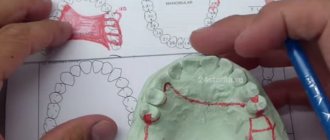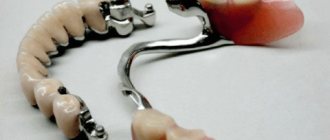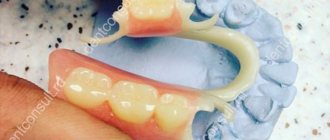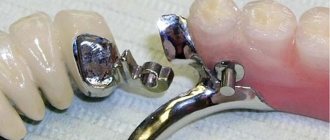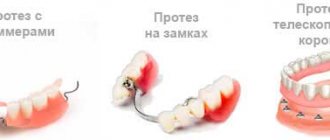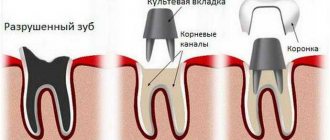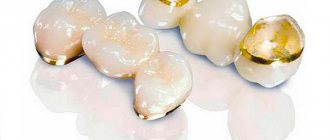The stages of making a clasp denture is a procedure that involves a professional and careful approach in dentistry. As a result of the step-by-step process, a product is obtained that successfully replaces implants and restores the dentition. The design is indicated for certain disorders and in the absence of natural units in the dentition. It is installed during the period of preparation for prosthetics to maintain aesthetics, correct deep bites, as well as for the treatment of periodontal disease and bruxism. Clasps have a number of advantages and, with proper care, last a long time. Modern orthopedic dentistry offers several types of clasps, for the manufacture of which special materials are used.
What is a clasp prosthesis?
Bugel devices belong to the removable devices of the budget segment. For the first time, this prosthetic technique was proposed by German specialists, who proposed using models with a special metal arch to which artificial teeth are attached. Hence the name bugel attached to the design, which translated from German means “arc” or “which has an arc.”
The clasp prosthesis consists of:
- metal (and in some cases plastic) arc;
- base imitating gum;
- artificial teeth attached to the base;
- fixing elements (hooks, clasps or crowns).
Clasp dentures are suitable for both jaws. According to the method of distributing the chewing load, they are something between bridge-like and plate analogues. Depending on the type of construction, the clasp can be based on:
- natural teeth (or installed implants);
- alveolar processes;
- jaw surface;
- soft sky.
Accordingly, chewing pressure on mucous tissues and supporting units is transmitted through the plastic base and locking systems. There are models that distribute the chewing load mixed, that is, simultaneously on the metal frame, supporting teeth and gums, which is much better for the living tissues of the oral cavity.
Manufacturing stages
Clasp dentures are complex orthopedic structures, the manufacture of which requires not only extensive experience of dental specialists, but also painstaking care. If the dentist tells you that the prosthesis will be ready in 2-4 weeks, know that this is a reasonable period of time, since during this time the following manipulations will be performed in the laboratory:
- Based on the impression taken of the patient's jaw, a prototype is cast. For this purpose, durable marble gypsum is used, which is easy to use and does not collapse during further manipulations.
- The outline of the frame is applied to the manufactured prototype model.
- The frame is modeled and the prosthesis itself is manufactured.
- The frame is cast, after which it is ground and polished.
- The frame is fitted to the prosthesis.
- Using wax, artificial teeth are modeled (selected). This takes into account the size, shape and installation location.
- The finished temporary option is tried on for the patient. If necessary, adjustments are made.
- Taking into account all the changes made, wax teeth are replaced with plastic teeth.
- Final (finishing) processing is carried out.
The quality of the finished design and its ease of wearing depend on the qualifications of the orthopedic dentist taking impressions and the laboratory specialist. It is better to choose a clinic whose doctors you completely trust and get detailed advice on clasp dentures there.
Peculiarities
The main features of clasp dentures are the following:
- light in weight and look very aesthetically pleasing (most of the models for others do not differ from natural teeth);
- minimally affect diction and perception of tastes;
- affordable (compared to non-removable analogues);
- service life (depending on the model) – 5-10 years;
- do not require special care (can be easily cleaned using special products);
- You can use clasp dentures around the clock, removing them only for cleaning;
- do not require frequent professional hygiene care (it is better to visit the dentist once every 2-3 months);
- not suitable for completely edentulous patients - several teeth (or implants) in a row are required for fixation;
- the design is very stable throughout its entire service life (subject to the rules of use);
- you can choose options to match healthy teeth, achieving maximum aesthetics.
A wide range of clasp devices allows you to choose the best option for almost everyone who has no contraindications. The final decision on installing a specific type of clasp is made by the orthopedic dentist.
Features of the clinical stage
This stage involves several visits to the orthodontist, during which the following is performed:
- examination of the patient - based on its results, a treatment plan is drawn up;
- selection/preparation (treatment, grinding) of abutment teeth - special attention is paid to this stage in order to avoid overload and loss of healthy teeth during use;
- creating a cast of the jaw – several impressions are made for each jaw;
- production of a model of the prosthesis based on the impression obtained, experimental fitting of the finished product, making adjustments if necessary;
- final fastening of the device in the oral cavity.
Types of clasp dentures
Modern orthopedic designs are presented in a variety of options, which differ:
- by type of manufacture;
- by type of fixation.
To understand which clasp dentures are better for teeth and how the models differ from each other, it is necessary to consider each type in more detail.
By type of manufacture
The durability of the orthopedic structure depends on the manufacturing features. Based on this feature, there are several types:
- solid cast;
- soldered;
- milled;
- made by sintering a metal alloy with a special powder.
The most popular and in demand are solid clasp dentures, which are made in one of two ways:
- Based on the impressions taken from the patient, a wax structure is made and then casting is carried out. The resulting plaster model is freed from wax and covered with one of the refractory masses, due to which the wax melts and metal takes its place.
- The prosthesis is cast from fire-resistant material. The frame of the arch is formed from wax. This is the most common method, since metal shrinkage does not occur after, but already at the manufacturing stage. This means that after wax filling and subsequent packaging in a fire-resistant mass, the prosthesis will not lose its original shape.
If you have a choice, then it is better to choose the second method. Such clasp dentures are light in weight and match the gum casts as closely as possible. This guarantees quick and painless adaptation to the structure after its installation.
By type of fixation
The optimally suitable design is selected based on the location of the existing teeth, the presence and size of the spaces between them and taking into account the anatomical shape of the units. According to the method of fastening, clasp dentures are divided into 5 types:
- On clasps
. It is considered the simplest, but allows you to fully restore chewing function. Clasps are hooks with the help of which they are fixed to their own supporting teeth, clasping them. This prosthetic technique does not require the use of crowns, grinding or depulpation of teeth. At the same time, the finished result does not look aesthetically pleasing, since the clasp hooks can be visible when you smile. - Telescopic
. Such clasp dentures are orthodontic devices that require preliminary installation of a non-removable metal telescopic crown on the supporting units. The clasp design has a hollow crown larger in size than the one already on the tooth. During installation, one is put on top of the other, ensuring secure fixation. All types of telescopic models are difficult to manufacture and have a number of contraindications. - On locks (attachments)
. It is a type of telescopic device, but involves the use of locks (attachments). It consists of two parts - one is attached to the turned units, and the second is attached to the prosthesis itself. When fixed, a snap occurs, which guarantees strong adhesion of the parts of the structure, ensuring the most uniform chewing load. The locks are located on the inside, so they are not noticeable when smiling. - Splinting
. Allows you to effectively solve two problems - prosthetics and strengthening of the dentition in order to prevent its further loosening. The main difference from analogues is that on the inside there is an additional arc or claw-shaped metal processes that fix the movable units. - Quadrotti prosthesis
. All parts of such a clasp prosthesis are made of translucent plastic. The result is a plastic but durable structure that bends rather than breaks under dynamic loads. This is an ideal solution for those patients who have contraindications to other types of prosthetics or are diagnosed with an allergy to metal. These devices are also indicated for people who have an increased risk of injury, for example, athletes, firefighters, rescuers, etc.
Unlike other removable structures, which are fixed by suction to the gum or glue, fastening clasp dentures is better, since it allows you to avoid spontaneous falling out of the artificial apparatus from the mouth.
General overview
Clasp denture is one of the types of removable orthodontic structures. This is a very light, elegant, reliable and comfortable device to wear that does not distort diction.
All models of clasps are technically complex. They are based on a durable metal frame, a saddle-shaped acrylic base, artificial units and fastening devices.
All parts of the device are connected to each other by an arc. It also performs a fixing function. The frame itself can be made in two versions - solid cast or soldered. The second one is much easier to produce, cheaper, but not so convenient to use.
An important condition for the installation of these products is the presence in the mouth of several fairly stable and strong teeth. It is these units that will hold the removable structure.
The degree of sensitivity of the tissues and mucous membranes of the gums, the condition of the periodontium, and the size and shape of the alveoli are also of great importance.
Which clasp dentures are better for teeth?
Frankly, it is impossible to compare designs with each other and determine which clasp dentures are better for teeth. For the most part, patients consider this type of prosthetics as temporary before implantation. They are left as permanent ones by those who cannot afford alternative methods.
Each type of clasp dentures has its own advantages, indications and contraindications and is recommended in strictly defined cases after studying the clinical picture. The main thing that patients need to know is that even the best orthopedic structures can cause harm if they are improperly manufactured or installed. Turning to inexperienced and incompetent dentists can result in the following troubles:
- breakdown of supporting units (most often within several months after installation of the prosthesis);
- a pathological bite is formed;
- possible deformation of the temporomandibular joint;
- the speed and intensity of tooth abrasion increases;
- complex diction disorders appear that do not go away over time.
An experienced orthopedic dentist can tell you which clasp dentures are best for your teeth.
Dental laboratory
- Own laboratory
The FDC clinic has its own dental laboratory, equipped with the latest technology, so even the most labor-intensive orthopedic work is performed in the shortest possible time.
- Laboratory in France
Exclusive work, if necessary, can also be performed in the most prestigious dental laboratory in France, Bourbon Atelierd' Art Dentaire (Nice)
Purpose of structures
A clasp denture is one of many structures designed to reconstruct the integrity of the dentition in the absence of natural units on it.
Its installation is possible for the following indications:
- the presence of end bilateral and unilateral defects of the row;
- inability to place a non-removable device;
- loose teeth associated with periodontal diseases;
- the presence of single or included defects;
- replacement of anterior units;
- pathological abrasion of teeth.
The clasp is very often installed during preparation for prosthetics to preserve the overall aesthetics of the face. It can be used to correct deep bites, treat periodontal disease and bruxism.
Contraindications
In addition to prescriptions for the use of clasp dentures, dentists identify conditions in which their installation is impossible. These restrictions can be divided into 2 groups: absolute and temporary (conditional).
Absolute restrictions include the following conditions:
- insufficient height of supporting teeth or their absence;
- pathological changes in structure in the periapecal tissues of these units;
- atrophy of the alveolar processes;
- severe malocclusion of the lower jaw;
- low, or, on the contrary, high fixation of the frenulum of the tongue;
- mental disorders;
- diabetes;
- pathologies that weaken the immune system;
- malignant formation in the oral cavity.
Important! Identification of one of these conditions is the basis for refusal to perform prosthetics and a reason for selecting another method of correcting the dentition defect.
The group of relative contraindications includes:
- pregnancy at any stage and the period of breastfeeding;
- exacerbation of existing chronic diseases;
- recovery period after surgery;
- insufficient number of supporting teeth;
- drug or alcohol addiction;
- heart failure in the active phase;
- insufficient oral hygiene;
- viral or infectious diseases.
Important! Considering that a significant part of the limitations can be eliminated, prosthetics with clasp devices is a real way to reconstruct the dentition.
Rules of care
The service life of the system, subject to strict adherence to all rules of care, is approximately 10 years. Also, their implementation will help prevent inflammation of the mucous and periodontal tissues:
- It is good to rinse your mouth with water or mouthwash after each meal.
- Clean the structure twice a day, being sure to remove it before the procedure.
- Treat in the same way as natural teeth, using paste and a classic brush. Highly abrasive pastes should not be used for the procedure.
- Each time after removal, treat with an antiseptic (it is better to do this before going to bed).
- Rinse only with warm water. Do not use alkalis or highly acidic products.
- Eliminate hard and sticky foods from your diet, and avoid hot foods and drinks.
- Protect from accidental falls and breakages.
It is also necessary to perform position adjustments and professional dental cleanings at least once a year.
.
The above rules of care are simple and easy to follow. Compliance with them will ensure the preservation of the functionality of the system and comfort during operation.
Reviews
Clasp dentures are considered a worthy replacement for lost dental units. They received a lot of positive ratings from experts and people who tested their characteristics from their own experience.
They note reliability, quality, comfort, convenience and long-term operation without repair.
You can talk about your experience and share your impressions of dentition reconstruction with clasps by leaving a comment on this article.
If you find an error, please select a piece of text and press Ctrl+Enter.
Tags clasp denture removable dentures
Did you like the article? stay tuned
Material used
All structural elements of the system are made using different materials. So, for the manufacture of the frame and arc, a cobalt-nickel alloy or stainless steel .
The alloy product is hypoallergenic and has a high biocompatibility with periodontal tissues.
Less popular is the system, the parts of which are made of steel. Its disadvantage is that an oxide film forms very quickly at the soldering points (its appearance indicates the beginning of the oxidation process).
The base on which the artificial chewing elements are placed is usually made of acrylic (a type of plastic). Despite the lightness of the material, it is quite durable.
All small elements (including fasteners) are made of titanium, which reduces the overall weight and parameters of the product. It is this fact that reduces the adaptation period to the system to 3-5 days.
For artificial chewing elements, metal-ceramics or ceramics (plastics are used less frequently).
Where does the process of making removable dentures begin, and what material is used?
Find out about the effectiveness of denture retaining spacers here.
At this address https://zubovv.ru/protezirovanie/semnyie-p/komu-podoydut-akri-fri.html you will find a selection of positive and negative reviews about Akri Fri removable dentures.
Advantages and disadvantages
Clasp prosthetics have the following significant advantages over other removable orthodontic structures:
- Compact and lightweight.
- Good fixation in the mouth.
- Correct pressure distribution during eating.
- When the system is attached to the upper jaw, it does not cover the entire palate, which means it does not lead to a change in the taste perception of food or impaired diction.
- Easy to care for.
- Duration of operation.
- Possibility of installation for the treatment of periodontal diseases.
- Various fixation methods.
- Short adaptation period.
The invention of structures pushed into the background all other removable systems. Today, clasps are considered the best options for replacing lost teeth.
But even despite the large number of advantages, this device has a number of disadvantages:
- For placement it is necessary to perform turning.
- The process of atrophy of jaw tissue develops.
- Some types of fastening (clasps) are not aesthetically pleasing.
- High cost compared to other designs.
But even these shortcomings do not affect the demand and popularity of clasps among patients.
Price
The cost of prosthetics using a splinting clasp prosthesis varies in each individual case, which is explained by design parameters, type of locking elements and other factors.
Approximate prices for installing a prosthesis:
- product with 2-3 clasps – 50,000-53,000 rubles;
- product with “Bredent” locking mounts – from RUB 90,000;
- elimination of single-end defects with products on MK-1 attachments – from 108,000 rubles;
- elimination of a single-end defect with products made of a special alloy with attachments – from RUB 280,000.
The high cost of splinting structures is due to the high time required to produce the product and the high-tech manufacturing process.
